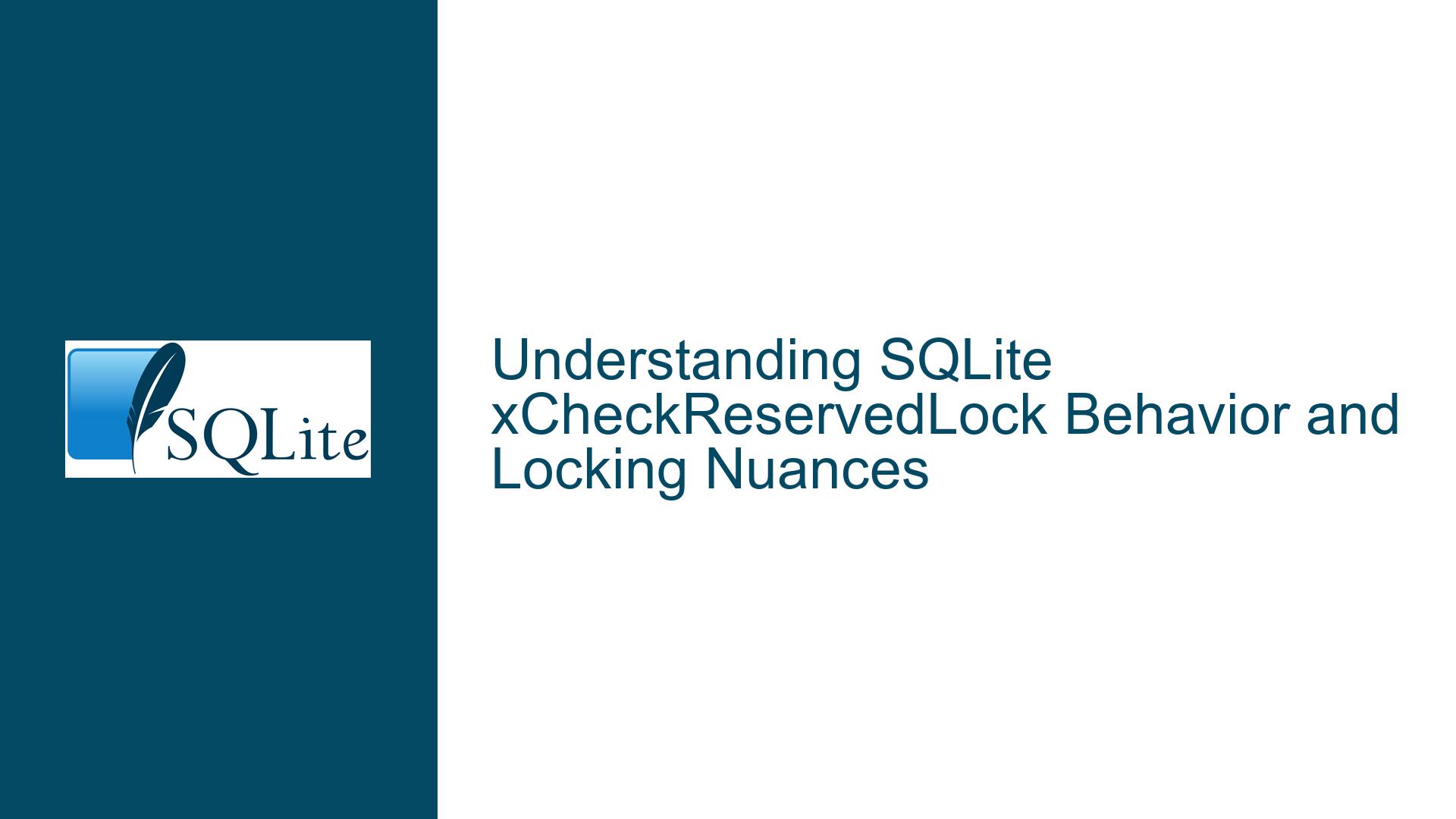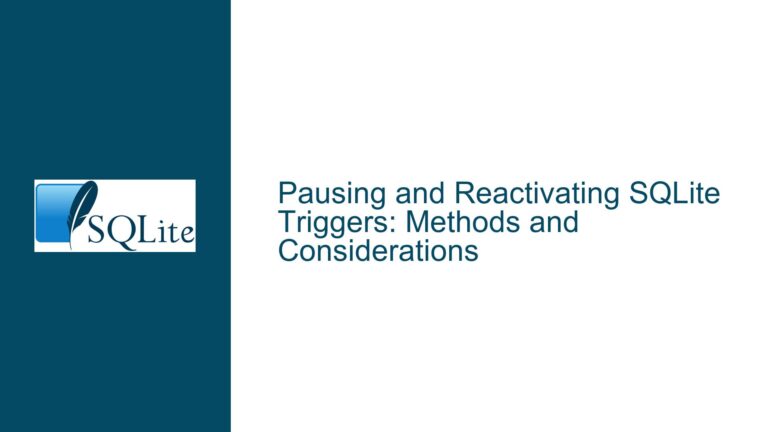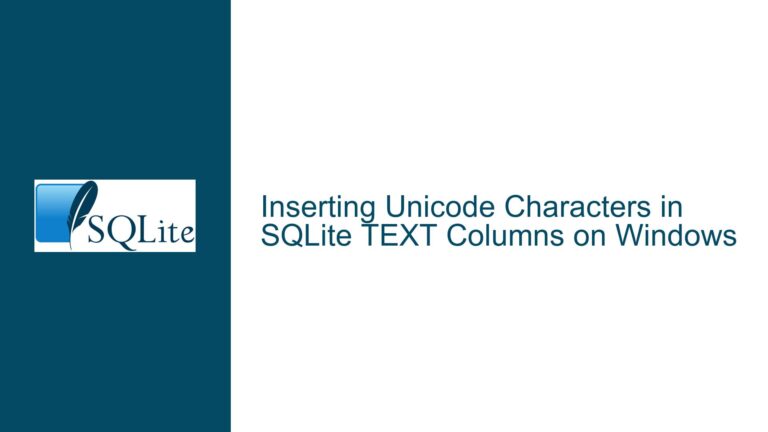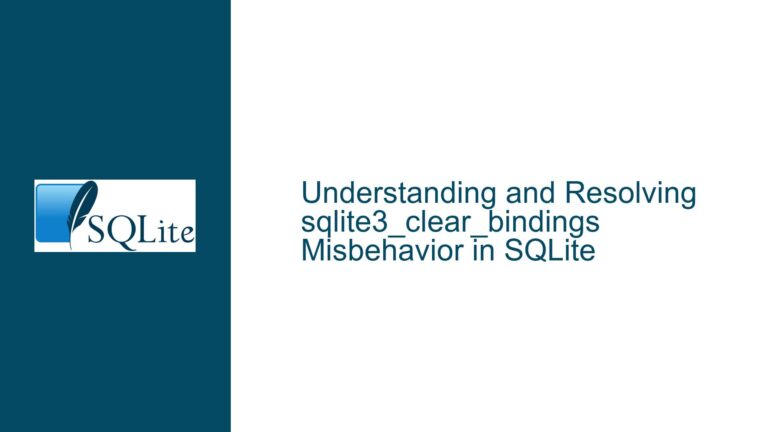SQLite xCheckReservedLock Behavior and Locking Nuances
Issue Overview: xCheckReservedLock Specification vs. Implementation Discrepancy
The core issue revolves around the behavior of the xCheckReservedLock function in SQLite, specifically its implementation in the context of file locking mechanisms. The function is documented as checking whether any database connection, either in the current process or another process, holds a RESERVED, PENDING, or EXCLUSIVE lock on a database file. However, the implementation in os_unix.c and os_win.c reveals discrepancies between the documented behavior and the actual code.
In os_unix.c, the xCheckReservedLock function checks two scenarios: (a) whether a thread in the current process holds a RESERVED, PENDING, or EXCLUSIVE lock, and (b) whether another process holds a RESERVED lock. For scenario (a), the code tests if the lock level is greater than SHARED_LOCK. For scenario (b), it only checks the RESERVED_BYTE in the file, ignoring PENDING and EXCLUSIVE locks held by other processes. This behavior raises questions about whether the implementation aligns with the specification, especially given the nuances of SQLite’s locking model.
The issue is further complicated by the fact that a process does not need to acquire a RESERVED lock before obtaining a PENDING or EXCLUSIVE lock. This design choice is intentional, as it allows SQLite to roll back a journal file after a crash without requiring a RESERVED lock. However, this creates a situation where the xCheckReservedLock function might not detect a PENDING or EXCLUSIVE lock held by another process, potentially leading to unexpected behavior such as BUSY errors.
Additionally, the xUnlock function introduces another layer of complexity. When a thread holding an EXCLUSIVE lock releases it, it may also release a RESERVED lock held by another thread in the same process. This can lead to a situation where a thread assumes it still holds a RESERVED lock, but in reality, it does not. While this does not cause data corruption (since RESERVED locks are functionally equivalent to SHARED locks), it can result in unexpected BUSY errors or other concurrency-related issues.
Possible Causes: Locking Mechanism Design and Implementation Choices
The discrepancies between the documented behavior and the implementation of xCheckReservedLock can be attributed to several factors, including the design of SQLite’s locking mechanism and the specific implementation choices made in os_unix.c and os_win.c.
One key factor is the optimization of the PENDING lock. The PENDING lock is an optimization that prevents new SHARED locks from being acquired while a process is attempting to upgrade to an EXCLUSIVE lock. However, this optimization introduces complexity, especially when dealing with transitions between different lock levels. For example, a process can transition directly from a SHARED lock to an EXCLUSIVE lock without acquiring a RESERVED lock, which is a common scenario during journal rollback after a crash. This behavior is intentional but can lead to confusion when implementing xCheckReservedLock.
Another factor is the difference in locking behavior between Unix-like systems and Windows. On Unix-like systems, the xCheckReservedLock function checks the RESERVED_BYTE for other processes but does not check for PENDING or EXCLUSIVE locks. This is due to the peculiarities of POSIX file locking, where locks are not automatically inherited by child processes and where threads within the same process share the same file descriptor. On Windows, the locking behavior is different, and the xCheckReservedLock function always checks the RESERVED_BYTE for a file-system lock, avoiding the issues present in Unix-like systems.
The implementation of xUnlock also plays a role in the issue. When a thread releases an EXCLUSIVE lock, it may inadvertently release a RESERVED lock held by another thread in the same process. This behavior is a consequence of the way locks are managed within a process and can lead to unexpected BUSY errors if not handled correctly.
Troubleshooting Steps, Solutions & Fixes: Addressing the Locking Discrepancies
To address the discrepancies between the documented behavior and the implementation of xCheckReservedLock, several steps can be taken. These steps involve understanding the locking mechanism, making informed implementation choices, and ensuring compatibility across different platforms.
First, it is essential to understand the role of the PENDING lock and its impact on the locking mechanism. As Dan Kennedy pointed out, the PENDING lock is an optimization that can be omitted initially to simplify the implementation. By focusing on the core locking behavior (i.e., SHARED, RESERVED, and EXCLUSIVE locks), you can avoid the complexity introduced by the PENDING lock. Once the core functionality is working correctly, the PENDING lock can be added as an optimization to prevent writer starvation.
When implementing xCheckReservedLock, it is crucial to ensure that the function correctly detects RESERVED, PENDING, and EXCLUSIVE locks held by other processes. On Unix-like systems, this may require additional checks beyond the RESERVED_BYTE to detect PENDING and EXCLUSIVE locks. However, as Dan Kennedy noted, the current implementation in os_unix.c does not perform these checks, which can lead to subtle race conditions. To avoid these race conditions, the xCheckReservedLock function should only return true if a RESERVED lock is held, ignoring PENDING and EXCLUSIVE locks in certain scenarios.
For the xUnlock function, care must be taken to ensure that releasing an EXCLUSIVE lock does not inadvertently release a RESERVED lock held by another thread in the same process. This can be achieved by carefully managing the lock state within the process and ensuring that each thread’s locks are tracked independently. On Unix-like systems, this may involve using thread-local storage or other mechanisms to track locks at the thread level.
On Windows, the locking behavior is different, and the xCheckReservedLock function does not face the same issues as on Unix-like systems. However, it is still important to ensure that the implementation is consistent with the documented behavior and that the PENDING lock is handled correctly. As Dan Kennedy pointed out, Windows does not require the same level of complexity in lock handling due to differences in file locking behavior.
In summary, the key to resolving the discrepancies in xCheckReservedLock lies in understanding the nuances of SQLite’s locking mechanism, making informed implementation choices, and ensuring compatibility across different platforms. By focusing on the core locking behavior and carefully managing lock states, you can avoid the subtle race conditions and unexpected behavior that arise from the current implementation. Additionally, by omitting the PENDING lock initially and adding it as an optimization later, you can simplify the implementation and reduce the risk of errors.
Finally, it is important to test the implementation thoroughly to ensure that it behaves as expected in all scenarios. This includes testing with multiple processes and threads, as well as testing on different platforms to ensure compatibility. By following these steps, you can implement a robust and reliable locking mechanism that aligns with SQLite’s documented behavior and avoids the pitfalls of the current implementation.






